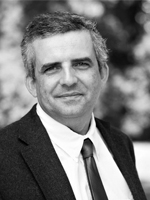Prof. Philip Clart, Ph.D.

Areas of interest
- Chinese popular religion
- popular sects
- religious change in early modern and modern China
- Daoism, Confucianism, Chinese literature, religion
Religious museums in Taiwan
I will investigate the negotiation of sacred and secular spaces in present-day Taiwan, with “religious museums” as a case example. A religious museum is defined here as one that is designed, run, and managed by a religious organisation; such museums raise a number of interesting questions regarding the religious organisation’s rationale for, and specific approach to, setting up and running a museum. I will, on the one hand, focus on the strategic discourses within religious organisations concerning the aims and purposes of their museum projects, in particular with regard to the definition and differentiation of secular and sacred spaces and functions; on the other hand, I will examine the museums’ functionality within the sponsoring religious organisations’ ongoing negotiation of their relationship with secular institutions and agents. I expect the role of government to be particularly important as laws and official regulations create the legal and political framework for establishing and running museums as quasi-public service institutions.
The study will focus on a handful of case examples, currently limited to three, which include:
- The Buddha Memorial Centre 佛光山佛院紀念館 (Kaohsiung), a hybrid structure combining devotional and museum spaces attached to (but physically separate from) the Foguangshan monastic complex;
- Museums attached to local community temples; here I intend to focus on two well-known Mazu 媽祖 temples, viz., the Chaotiangong in Beigang 北港朝天宮 and the Fengtiangong in Xin’gang 新港奉天宮.
The cases involve quite different settings and constellations of factors and issues. The Buddha Memorial Centre is run by a Buddhist monastic organisation with apparently dual religious and educational purposes, while the museums directed by local Mazu temples are closely involved with and influenced by local and even national politics and their museums are multifaceted ventures involving local identities, inter-temple rivalries, and national cultural policies (such as the promotion of local culture centres, wenhua zhongxin 文化中心). I plan to investigate these cases paying particular attention to the following aspects: the museum’s social functions for and within the religious institution; its conceptualisation and interpretation by the religious institution; its interactions with other secular and religious agents.
Biography
Professor, Chinese Studies, Leipzig University, Leipzig (Germany)
Associate Professor, Department of Religious Studies, University of Missouri-Columbia, Missouri (USA)
Assistant Professor, Department of Religious Studies, University of Missouri-Columbia, Missouri (USA)
PhD, University of British Columbia, Vancouver (Canada)
Relevant Publications
- Clart, Philip. “New Technologies and the Production of Religious Texts in China, 19th to 21st Century,” in Modern Chinese Religion II, 1850-2015, vol. 1. Edited by Vincent Goossaert, Jan Kiely, and John Lagerwey, 560–78. Leiden: Brill, 2016.
- Clart, Philip and Gregory Adam Scott, eds. Religious Publishing and Print Culture in Modern China: 1800-2012. Boston, Berlin: de Gruyter, 2015.
- Clart, Philip. “Religion und Religionspolitik in China: Historische Grundlagen und aktuelle Perspektiven,” in Länderbericht China. Edited by Doris Fischer and Christoph Müller-Hofstede, 607–40. Bonn: Bundeszentrale für politische Bildung, 2014.
- Clart, Philip. “Conceptualizations of ‘Popular Religion’ in Recent Research in the People’s Republic of China,” in Yanjiu xin shijie: “Mazu yu Huaren minjian xinyang” guoji yantaohui lunwenji. Edited by Wang Chien-chuan, Li Shiwei and Hong Yingfa, 391–412. Taipei: Boyang, 2014.
- Clart, Philip. “’Religious Ecology’ as a New Model for the Study of Religious Diversity in China,” in Religious Diversity in Chinese Thought. Edited by Perry Schmidt-Leukel and Joachim Gentz, 187–99. New York: Palgrave Macmillan, 2013.
- Clart, Philip. „Mediums and the New Media: The Impact of Electronic Publishing on Temple and Moral Economies in Taiwanese Popular Religion.“ Journal of Sinological Studies / 汉学研究学刊, 3 (2012): 127–41.
- Clart, Philip. “Chinese Popular Religion,” in The Wiley-Blackwell Companion to Chinese Religions. Edited by Randall Nadeau, 219–35. Oxford: Wiley-Blackwell, 2012.
- Clart, Philip. Chinese and European Perspectives on the Study of Chinese Popular Religions. Taipei: Boyang Publishing, 2012.
- Clart, Philip. “Parteikader und Drachenkönige: Niedergang und Rückkehr der Volksreligion in der Volksrepublik China,” in Religionen und gesellschaftlicher Wandel in China. Edited by Iwo Amelung and Thomas Schreijäck, 129–42. Munich: Iudicium, 2012.
- Clart, Philip. Die Religionen Chinas. Göttingen: Vandenhoeck & Ruprecht, 2009.
- Clart, Philip. "The Eight Immortals between Daoism and Popular Religion: Evidence from a New Spirit-Written Scripture," in Foundations of Daoist Ritual: A Berlin Symposium. Edited by Florian C. Reiter, 84–106. Wiesbaden: Harrassowitz, 2009.
- Clart, Philip and Paul Crowe. The People and the Dao: New Studies of Chinese Religions in Honour of Daniel L. Overmyer. Sankt Augustin: Institut Monumenta Serica, 2009.
- Clart, Philip. "The Relationship of Myth and Cult in Chinese Popular Religion: Some Remarks on Han Xiangzi." Xingda zhongwen xuebao, 23 (2008): 479–513. (Supplementary issue, zengkan)
- Clart, Philipp. "The Concept of Ritual in the Thought of Sima Guang (1019-1086)," in Perceptions of Antiquity in Chinese Civilization. Edited by Dieter Kuhn and Helga Stahl, 237-52. Heidelberg: edition forum, 2008.
- Clart, Philip. Han Xiangzi: The Alchemical Adventures of a Daoist Immortal. Seattle, WA: University of Washington Press, 2007.
- Clart, Philip. "The Concept of 'Popular Religion' in the Study of Chinese Religions: Retrospect and Prospects," in The Fourth Fu Jen University Sinological Symposium: Research on Religions in China: Status quo and Perspectives. Edited by Zbigniew Wesolowski, 166–203. Xinzhuang: Furen Daxue chubanshe, 2007 (reprinted in: Critical Readings on Religions in China. Edited by Vincent Goossaert, 359–410. Leiden: Brill, 2012).
- Clart, Philip. "The Role of Jesus in Chinese Popular Sects," "Yesu zai Huaren minjian zongjiao zhong banyan de jiaose." Taiwan zongjiao yanjiu tongxun, 5(2003): 237–58).
- Clart, Philip. "The Image of Jesus Christ in a Chinese Inclusivist Context: I-kuan Tao's Christology and Its Implications for Interreligious Dialogue," in Zongjiao, wenxue yu rensheng. Edited by Chung Yun-Ying, 279–313. Chungli: Yuanzhi Daxue Zhongwenxi, 2006.
- Clart, Philip. "Generals, Pigs, and Immortals: Views and Uses of History in Chinese Morality Books." Journal of Ritual Studies, 19/1 (2005): 99–113 (Republished in Asian Ritual Systems: Syncretisms and Ruptures. Edited by Pamela J. Stewart and Andrew Strathern, 209-238, Durham, NC: Carolina Academic Press, 2007).
- Clart, Philip and Charles B. Jones. Religion in Modern Taiwan: Tradition and Innovation in a Changing Society. Honolulu: University of Hawai'i Press, 2003.
- Clart, Philip. "Confucius and the Mediums: Is There a 'Popular Confucianism'?" T'oung Pao: International Journal of Chinese Studies, 89/1-3(2003): 1–38.
- Clart, Philip. "Moral Mediums: Spirit-Writing and the Cultural Construction of Chinese Spirit-Mediumship." Ethnologies, 25/1 (2003): 153–90.
- Clart, Philip. "Opening the Wilderness for the Way of Heaven: A Chinese New Religion in the Greater Vancouver Area." Journal of Chinese Religions, 28 (2000): 127–44.


